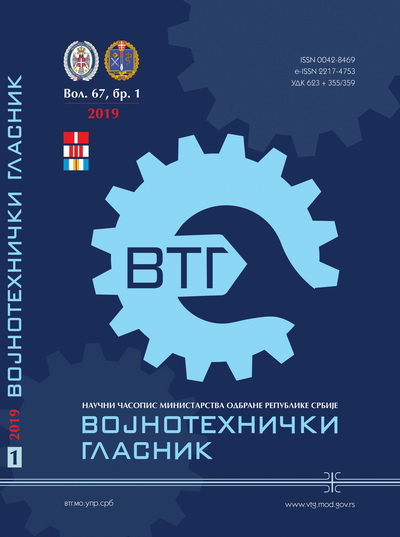Karakteristike plazma sprej prevlaka
Sažetak
Karakteristike plazma sprej prevlaka su u direktnoj vezi sa vrstom primenjenog procesa (APS ‒ atmospheric plasma spray, VPS ‒ vacuum plasma spray i SPS ‒ suspension plasma spray), karakteristikama praha i parametrima depozicije praha. Svojstva plazma sprej prevlaka mogu se menjati i podešavati u zavisnosti od radnih uslova, odnosno namene prevlaka. Pri upotrebi istog praha u postupku depozicije mogu se postići različita svojstva prevlake, zavisno od namene. Ako se prevlaka deponuje za korozionu zaštitu i biomedicinsku primenu, neopohodno je da bude kompaktna, a kada se deponuje radi toplotne izolacije poželjno je da bude porozna. Čestice praha u plazmi su tečne kapi sfernog oblika koje u sudaru sa podlogom formiraju lamelarnu strukturu prevlake. Veći stepen topljenja praha i veća brzina istopljenih kapi proizvodi gušće strukture deponovanih slojeva. Na kontaktu sa podlogom deponovane čestice prenose toplotu radnom delu do hlađenja na temperaturu okoline. Ako se radni deo hladi komprimovanim vazduhom, očvršćavanje istopljenih kapi odvija se ekstremno brzo sa stubastim kristalima u lamelama. Cilj rada jeste da se opišu: uticaj temperature i brzine čestica praha na deformaciju i očvršćavanje čestica koje definiše odnos D/d, poroznost u prevlakama, hemijske promene u istopljenim česticama i kristalne promene u prevlakama, poroznost u prevlakama i unutrašnji naponi prevlaka.
Reference
Bull, S.J., & Rickerby, D.S. 2001. Characterization of hard coatings. In R.F. Bunshah Ed., Handbook of hard coatings.Park Ridge: Noyes Publications. pp.181-228.
Cetinel, H., Celik, E., & Kusoglu, M.I. 2008. Tribological behavior of Cr2O3 coatings as bearing materials. Journal of Materials Processing Technology, 196(1-3), pp.259-265. Available at: https://doi.org/10.1016/j.jmatprotec.2007.05.048.
Friis, M., Persson, C., & Wigren, J. 2001. Influence of particle in-flight characteristics on the microstructure of atmospheric plasma sprayed yttria stabilized ZrO2. Surface and Coatings Technology, 141(2-3), pp.115-127. Available at: https://doi.org/10.1016/s0257-8972(01)01239-7.
Johnston, R.E. 2009. The Sensitivity of Abradable Coating Residual Stresses to Varying Material Properties. Journal of Thermal Spray Technology, 18(5-6), pp.1004-1013. Available at: https://doi.org/10.1007/s11666-009-9378-2.
Li, C., Yang, G., & Ohmori, A. 2006. Relationship between particle erosion and lamellar microstructure for plasma-sprayed alumina coatings. Wear, 260(11-12), pp.1166-1172. Available at: https://doi.org/10.1016/j.wear.2005.07.006.
Mishin, J., Vardelle, M., Lesinski, J., & Fauchais, P. 2000. Two-colour pyrometer for the statistical measurement of the surface temperature of particles under thermal plasma conditions. Journal of Physics E: Scientific Instruments, 20(6), pp.620-625. Available at: https://doi.org/10.1088/0022-3735/20/6/008.
Moridi, A., Gangaraj, S.M.H., Vezzu, S., & Guagliano, M. 2014. Number of Passes and Thickness Effect on Mechanical Characteristics of Cold Spray Coating. Procedia Engineering, 74, pp.449-459. Available at: https://doi.org/10.1016/j.proeng.2014.06.296.
Mrdak, M., Rakin, M., Medjo, B., & Bajić, N. 2015. Experimental study of insulating properties and behaviour of thermal barrier coating systems in thermo cyclic conditions. Materials & Design, 67, pp.337-343. Available at: https://doi.org/10.1016/j.matdes.2014.11.029.
Mrdak, M. 2016. Properties of the ZrO2MgO/MgZrO3NiCr/NiCr triple-layer thermal barrier coating deposited by the atmospheric plasma spray process. Vojnotehnički glasnik/Military Technical Courier, 64(2), pp.411-430. Available at: https://doi.org/10.5937/vojtehg64-9612.
Mrdak, M. 2017. Mechanical properties and the microstructure of the plasma-sprayed ZrO2Y2O3 / ZrO2Y2O3CoNiCrAIY/ CoNiCrAIY coating. Vojnotehnički glasnik/Military Technical Courier, 65(1), pp.30-44. Available at: https://doi.org/10.5937/vojtehg65-10586.
Qiao, Y., Fischer, T.E., & Dent, A. 2003. The effects of fuel chemistry and feedstock powder structure on the mechanical and tribological properties of HVOF thermal-sprayed WC–Co coatings with very fine structures. Surface and Coatings Technology, 172(1), pp.24-41. Available at: https://doi.org/10.1016/s0257-8972(03)00242-1.
Sivakumar, D., & Nishiyama, H. 2004. Analysis of Madejski Splat-Quench Solidification Model With Modified Initial Conditions. Journal of Heat Transfer, 126(3), pp.485-489. Available at: https://doi.org/10.1115/1.1738421.
Sobieszczyk, S. 2010. Surface modifications of ti and its alloys. Advances in Materials Sciences, 10(1), pp.30-42. Available at: https://doi.org/10.2478/v10077-010-0003-3.
Vardelle, M., Vardelle, A., & Fauchais, P. 1993. Spray parameters and particle behavior relationships during plasma spraying. Journal of Thermal Spray Technology, 2(1), pp.79-91. Available at: https://doi.org/10.1007/bf02647426.
Vardelle, M., Vardelle, A., Fauchais, P., Li, K.-., Dussoubs, B., & Themelis, N.J. 2001. Controlling Particle Injection in Plasma Spraying. Journal of Thermal Spray Technology, 10(2), pp.267-284. Available at: https://doi.org/10.1361/105996301770349367.
Yang, H., Luan, W., & Tu, S. 2006. Corrosion Behavior and Thermal Conductivity of Plasma Sprayed AlN/Al2O3 Coating. Materials Transactions, 47(7), pp.1649-1653. Available at: https://doi.org/10.2320/matertrans.47.1649.
Vojnotehnički glasnik omogućava otvoreni pristup i, u skladu sa preporukom CEON-a, primenjuje Creative Commons odredbe o autorskim pravima:
Autori koji objavljuju u Vojnotehničkom glasniku pristaju na sledeće uslove:
- Autori zadržavaju autorska prava i pružaju časopisu pravo prvog objavljivanja rada i licenciraju ga Creative Commons licencom koja omogućava drugima da dele rad uz uslov navođenja autorstva i izvornog objavljivanja u ovom časopisu.
- Autori mogu izraditi zasebne, ugovorne aranžmane za neekskluzivnu distribuciju rada objavljenog u časopisu (npr. postavljanje u institucionalni repozitorijum ili objavljivanje u knjizi), uz navođenje da je rad izvorno objavljen u ovom časopisu.
- Autorima je dozvoljeno i podstiču se da postave objavljeni rad onlajn (npr. u institucionalnom repozitorijumu ili na svojim internet stranicama) pre i tokom postupka prijave priloga, s obzirom da takav postupak može voditi produktivnoj razmeni ideja i ranijoj i većoj citiranosti objavljenog rada (up. Efekat otvorenog pristupa).

